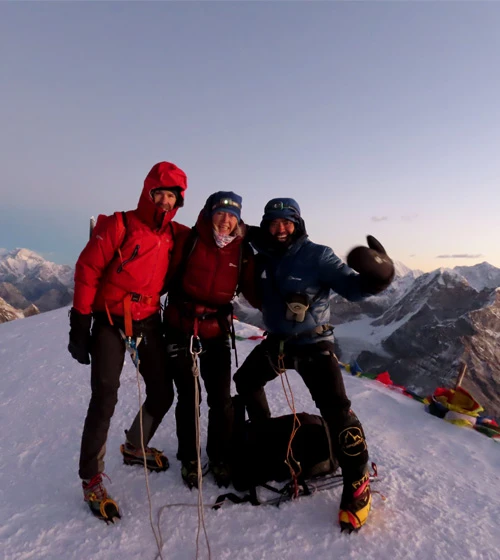Trip Overview
Climbing Chulu West Peak is more than just a physical challenge—it’s an opportunity to immerse yourself in the rich cultures and stunning natural beauty of the Famous Annapurna Circuit Trail. You will get to experience the welcoming smiles of the local people to the stunning views from the summit, this journey offers an adventure of a lifetime. Whether you're a seasoned mountaineer or an experienced trekker looking for a new challenge, the climb to Chulu West Peak provides a perfect balance of mountaineering experience. The gradual ascent from lower land allows for excellent acclimatization, and the variety of landscapes you’ll traverse ensures that each day is filled with new wonders to explore.
From the summit of Chulu West Peak, you will see iconic mountain views such as Annapurna Massif, including Annapurna II, Annapurna IV, and Gangapurna, as well as the mighty Manaslu and Dhaulagiri. The changing landscapes, from green valleys to arid highlands, allow you to witness the full range of nature’s power, making it one of the most scenic treks in the world.
Climbing Chulu West Peak
After spending a few days acclimatizing at higher camps such as Chulu Base Camp (4,900m), High Camp (5100m), Camp one (5600m), climbers make their final push to the summit with fixed ropes. The climb is challenging but achievable for climbers with some previous mountaineering experience or for those willing to take on a more technical adventure with the guidance of experienced sherpas.
The route is typically done using ice axes, crampons, and ropes as you ascend the snow and ice slopes of the peak. While the climb does not require advanced technical climbing skills, it demands a good level of fitness, stamina, and the ability to navigate the mountain’s icy terrain. As you gain elevation, the views become more breathtaking with every step, offering a panoramic spectacle of the Annapurna range and beyond.
Standing on the summit of Chulu West is an experience like no other. The sense of achievement is immense, and the vistas—spanning over glaciers, snow-capped peaks, and deep valleys—are truly awe-inspiring. The sight of the world’s towering giants, all around you, is a humbling reminder of the vastness of nature.
Acclimatization and the Annapurna Circuit Trail
The journey begins from the lower land and ascends gradually, making it ideal for acclimatization. As you leave the lowlands behind, you'll pass through lush forests, picturesque villages, and terraced farmlands. The first days of the trek offer a great opportunity to adjust to the altitude while enjoying the rich cultural diversity of the region. The local inhabitants, primarily Gurung, Magar, Brammin, and Tibetan people, have lived in harmony with the mountains for centuries, and their hospitality and warmth make the journey even more special.
The trek starts from Besisahar, the gateway to the Annapurna Circuit, and continues along the Marsyangdi River, gradually gaining elevation. The terrain transforms from subtropical forests to alpine meadows, where you can spot yaks grazing and experience the stark beauty of the mountains. This progression ensures that your body has ample time to adjust, reducing the risk of altitude sickness.
Experience the Local culture and Hospitality
The Chulu West Peak route is more than just a climbing; it’s a cultural exploration. As you make your way through the various villages, you’ll encounter traditional stone houses, prayer flags fluttering in the wind, glacial lakes and Buddhist stupas that dot the landscape. The locals are incredibly welcoming and often invite trekkers into their homes for a cup of tea or a meal. Their hospitality is a highlight of the trek, and many visitors are touched by the warmth and kindness of the people they meet along the way.
One of the best aspects of trekking in this region is the chance to sample authentic Nepali cuisine. Meals like dal bhat (lentil soup with rice), momos (dumplings), and gundruk (fermented leafy greens) provide a taste of the local flavors, while warm chiya or salt tea is a favorite drink shared with fellow trekkers and guides after a long day's journey.
In higher-altitude villages like Manang, you'll experience a unique blend of Tibetan and Nepali culture, with Buddhist monasteries and prayer wheels adding to the spiritual atmosphere. The people here are friendly and eager to share their stories about their lifestyle, faith, and traditions.
The Journey Back
After summiting, you’ll return back to Manang and then drive toward Besisahar. The descent gives you a chance to reflect on your journey and appreciate the amazing diversity of the Annapurna region. The contrasts between the high-altitude desert and the lush valleys of the lower elevations are striking, and you’ll pass through a series of cultural villages, where you can once again interact with the locals and enjoy their generous hospitality.




